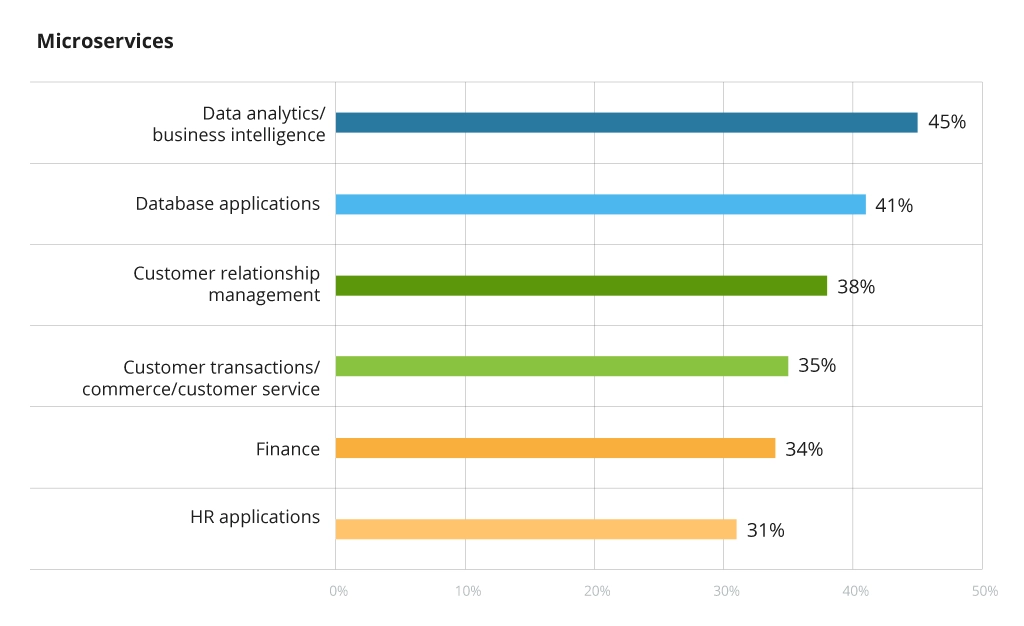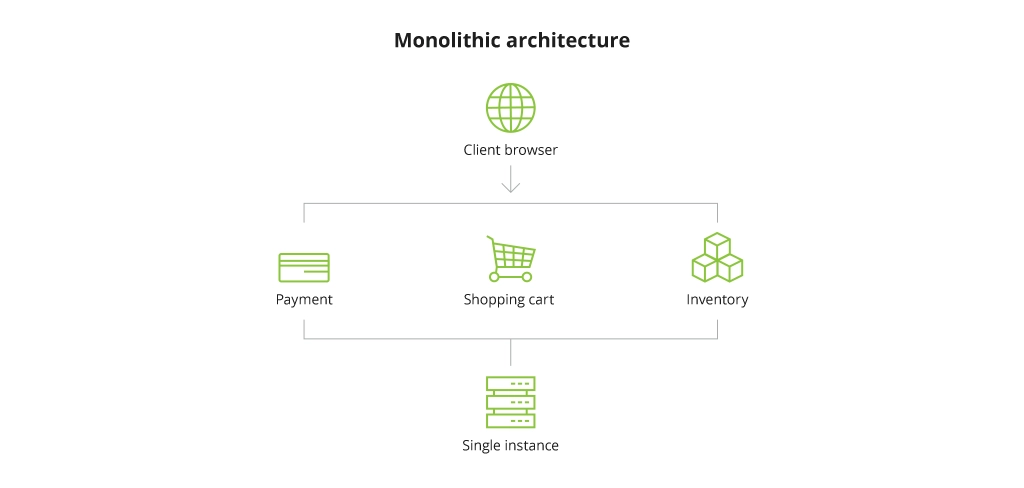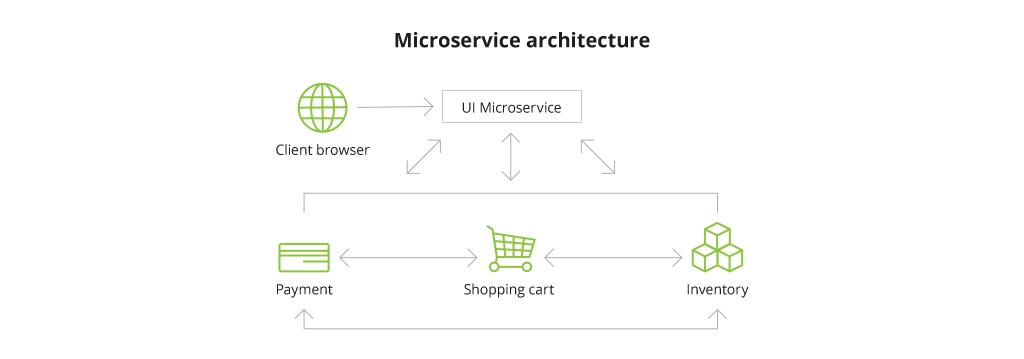How to Run Microservices in Azure: Key Services and Processes
Despite certain challenges, microservices have a number of use cases that make many companies around the globe try this architectural approach:
Using public cloud infrastructure when building microservices-based apps, developers can avoid a certain amount of overhead and hand it over to a vendor thus reducing costs. Constantly evolving, the cloud offers supporting services that help lower manual work and time spent on basics. Instead, engineers can concentrate on logic and business needs.
Let’s compare both traditional and microservices architecture as if we were to build an e-commerce solution, for example.
In scenario 1, the high-level architecture would be:
When choosing these timeless classics, you will not be able to scale separate modules and might run into trouble embracing new technology. Beyond that, you can experience ‘total meltdown’ in the case where one single component fails (read: ‘domino effect’). However, because of a centralized code base and repository, one API usually performs the same function that many of them perform in the case of microservices architecture.
In scenario 2, the architecture snapshot is the following:
The benefit of having it all split into smaller chunks is that separate teams are responsible for a microservice, a building block of the entire application. Thus, your agility is leveled up. At the same time, you are flexible to scale – it’s a matter of instant sizes and load capacity.
Microsoft Azure offers infrastructure, managed services, and an all-inclusive set of developer instruments that can help build reactive and resilient applications or migrate legacy ones using the microservice architecture.
Deploying Microservices Applications: Microsoft Azure Perks
Azure’s microservices offer global businesses a toolkit to create high-data-volume, low-latency applications. With the platform’s advantages, engineers can build and deploy microservices with ease thanks to:
- Hybrid environments for app deployment, offering a blend of on-premises, serverless, and cloud-native architectures.
- Out-of-the-box services in Azure which help easily and rapidly build microservices ecosystem.
- Scattered system of data centers across multiple geographies including the regions like Africa and APAC, usually not covered by other competitors.
TOP 3 Microsoft Azure Services to Deploy and Orchestrate Microservices
1. Azure Service Fabric
Overview:
Service Fabric is a portable infrastructure-independent framework used to create and deploy microservices-powered systems. It works based on a Platform as a Service (PaaS) model. Developers can use its programming paradigm or run container-based stateful services written in any language or code: the framework has a sharp focus on developing this type of services.
You can quickly build, deploy, package, and manage scalable and reliable microservices with low latency. Beyond that, you can restart failed services, manage states, route messages, and monitor the health of microservices using this platform. The significant thing about Azure Service Fabric is that it allows both stateless and stateful microservices. As per O’Reilly, the first ones do not maintain any state within the services across calls, but take in a request, process it, and feed the response back without persisting in any state information. A stateful microservice, in turn, persists in some form of state for it to function. As a whole, it simplifies the creation of microservices applications and streamlines application lifecycle management.
Benefits:
- Quick deployment. In Service Fabric, developers can save time creating VM instances. That’s the ‘by design’ capability of the Azure platform since it was made for small and large deployments alike, so scaling on request is easy. Thus, every deployment represents a structured bundle, enabling the seamless replication of the code across the environment.
- High-density hosting. Many applications can be deployed to fewer VMs, reducing overall deployment costs since applications in Service Fabric are disconnected from the VMs that run them. Service Fabric offers fully automated hosting for any number of services with any number of instances each (limited by a cluster’s physical capacity).
- Run everywhere. The Service Fabric apps can run both on Windows Server or Linux machines in public, private, or hybrid clouds, with minimal to no changes. The platform has an abstraction layer on top of the infrastructure. Thus, the application can run in different environments.
- Distributed application management. Service Fabric is a platform that can host distributed applications as well as offer a management suite to deal with lifecycle orchestration.
- Cross-region/DC deployment. Engineers can turn a DC-level disaster recovery into a usual failover that Service Fabric will handle automatically.
- Compliance. Azure Service Fabric Resource Provider is available in all Azure regions and corresponds to compliance certifications, including SOC, ISO, PCI DSS, HIPAA, and GDPR.
Whether you plan to create stateless or stateful microservices, you can use Microsoft Azure offerings to build architecture consisting of granular services, where apps present small, independently run services. In such a scenario, you can account for the most complex, low-latency, data-heavy scenarios and scale them into or across the cloud. On top of that, engineers who choose to employ Service Fabric can mix and match different programming languages and models to suit their particular needs.
Case in Point
A manufacturing giant, ABB, wanted to streamline its workforce management practices though intelligent tech. To keep up with evolving customer needs, the engineering company opted for Azure platform as a service (PaaS). It used Azure SQL Database, Azure Service Bus, and Azure Service Fabric to enable ABB’s Ability Ellipse Workforce Management through microservices-powered architecture. The main benefit realized through the project is elastic scalability: oftentimes energy supplies are jeopardized by weather storms, which requires real-time information about the damage in the field and extra field workforce to restore the power supply.
2. Azure Kubernetes Services
Overview:
Available on the Microsoft Azure public cloud, Azure Kubernetes Service or AKS is a managed container orchestration service with the open-source Kubernetes system at the core. Businesses use the service to deal with the deployment, scaling, and management of Docker containers and container-based apps.
As an open-source tool, Kubernetes requires handling a lot of overhead when it comes to cluster management. That’s where AKS takes part of the burden, lowering the deploying and managing efforts. Usually, businesses that choose the Azure architecture opt for AKS to create scalable applications with Kubernetes and Docker.
Benefits:
The many benefits of AKS are flexibility, automation, and the lower management overhead developers and administrators typically experience. In detail, the service:
- Automatically tunes up the Kubernetes nodes responsible for controlling and managing the worker nodes during the deployment process.
- AKS deals with Azure Active Directory (AD) integration, connections to monitoring services, and configuration of advanced networking features (e.g., HTTP application routing).
- To adjust to resource demand fluctuations, AKS nodes can scale up or down. AKS supports node pools powered by GPUs to elevate processing power even further. Such amplification can be essential for compute-intensive workloads.
On the one hand, Microsoft takes care of all Kubernetes upgrades, managing new version releases. On the other hand, users are to sign off if and when they want to update. This depends on the possibility of accidental workload disruption they are ready to embrace.
Furthermore, AKS streamlines horizontal scaling, redeployment in the case of partial failure (self-healing), load balancing, and secret management, using, for example, easily integrated Azure Key Vault.
Basically, AKS simplifies the process of running Kubernetes on Azure. It provides a hosted Kubernetes cluster that you can use for microservices deployment, eliminating the need to install or maintain your own Kubernetes control plane.
Case in Point
Qatari Q-Commerce app Snoonu had to search scalable solutions as its food delivery business was growing rapidly. Acceleration hindered the scalability and availability that was tackled with Microsoft Azure offerings. The company decided to re-engineer its app using microservices and containers with a message bus dealing with interservice-communication. Snoonu chose Database as a service, Azure Cache for Redis, AKS to deploy containers, and Azure API Gateway for interception requests. Quickly, the company could spot a significant elevation in systems availability. After the ‘remodeling’, Snoonu could scale elastically with the increased productivity of service-based dev teams sharpening their focus and concentrating on actual business tasks handing over the basics to the vendor.
3. Azure Functions
Overview:
Serving as a gateway to serverless microservices, Azure Functions is a compute service, enabling users to run event-triggered code without a need to set and manage infrastructure. Various events can serve as triggers or Azure Functions to run a script or a part of a code.
Triggered by real-time events instead of an entire container, the unit of work is a serverless function.
Benefits:
The beauty of Azure Functions is its ‘loyalty’: the service only charges you for actual runtime. It executes the code based on event triggers and finishes a function when the code terminates or the next event happens. Developers can build microservices exclusively with serverless features powered by messaging or streaming ‘event manager’ like Azure Event Grid or employ the serverless function to supplement the applications deployed in containers.
Overall, Azure Functions offers comprehensive development experience, built-in tools, and integrated DevOps practices and instruments.
Case in Point
Pet-case business, a daughter company of Mars Petcare, partnered with a Microsoft certified vendor to build a cloud-native app on Azure to tackle the challenges with referrals. Its legacy practice management software system powered by Windows Presentation Foundation was a monolithic application with tightly coupled business logic, its presentation, and data layers. After the feasibility study of potential changes, the company decided that re-engineering the system based on already used instruments was unlikely to solve the pressing scalability problem. Thus, the subsidiary of Mars Petcare chose microservices as an alternative option. Among other tools, the company used the advantages of geographically spread Azure Cosmos DB since the data on staff and organization is often consumed or referred to across regional offices and threw Azure Functions in the mix to orchestrate communications.
Bottomline
Microservices are not everyone’s cup of tea, for sure. However, when you do not want to deal with the complexity of legacy one-piece architecture, microservices can become that sweet escape. Monolith split in pieces is easier to manage and quick to scale. Although some suggest separate units are harder to debug and ensure standardization (speaking of logging methods, monitoring practices, and programming languages), microservices resonate with a secure, automated DevOps pipeline. Highly scalable, distributed solutions, and, as a result, safer global IT ecosystem.
![Microservices in Azure [banner]](https://www.infopulse.com/uploads/media/banner-1920x528-microsoft-azure-and-microservices-the-key-technologies-to-create-high-performing-apps_1.webp)




![Cloud-Native for Banking [thumbnail]](/uploads/media/cloud-native-solutions-for-banking_280x222.webp)
![Generative AI and Power BI [thumbnail]](/uploads/media/thumbnail-280x222-generative-AI-and-Power-BI-a-powerful.webp)
![Cloud Native vs. Cloud Agnostic [thumbnail]](/uploads/media/thumbnail-280x222-cloud-agnostic-vs-cloud-native-architecture-which-approach-to-choose.webp)
![DevOps Adoption Challenges [thumbnail]](/uploads/media/thumbnail-280x222-7-devops-challenges-for-efficient-adoption.webp)
![Azure Monitor for SAP [thumbnail]](/uploads/media/thumbnail-280x222-azure-monitor-for-sap-solutions-an-overview.webp)

![Mortgages Module Flexcube [Thumbnail]](/uploads/media/thumbnail-280x222-Secrets-of-setting-up-a-mortgage-module-in-Oracle-FlexCube.webp)
![Digital Alignment Drivers [thumbnail]](/uploads/media/thumbnail-280x222-the-top-forces-driving-digital-alignment.webp)
![AWS vs. Azure Cloud Platform [Thumbnail]](/uploads/media/thumbnail-280x222-comparison-of-aws-vs-azure-when-each-cloud-platform-works-best.webp)
![Cloud-Native Maturity Model Assessment [thumbnail]](/uploads/media/thumbnail-280x222-what-Is-the-cloud-native-maturity-model-definition-and-assessment-criteria.webp)